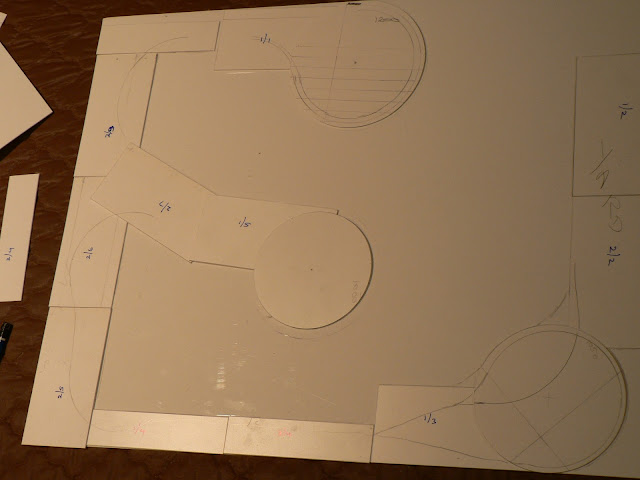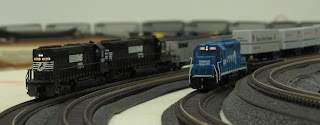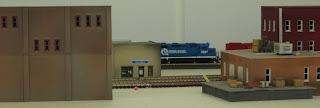You may have wondered what my layout construction rules were and where they came from. Just in case you weren't wondering, it's here anyway :-) They are adapted from an old Model Railroader article. When I get time I will search through the mountain of mags.
1. I know when & where
my railroad is located. I guess we all like a range of locos and rolling stock that spans a time period that exceeds the 'ideal' ie modelling depending on your preferences - January 27th 1965, Spring 1965, or 1965. I sort of care about 1970 to 1990, around Virginia, USA. That sort of nails things down to what I can be happy with. It means that I can run pre-Conrail locos and Conrail locos, if I choose to do so. I like -7's and -8's. I apparently like SD60's because I seem to have bought heaps of them! That's more a fault of buying before the layout is built and not really keeping track of what I have.
2. Trains will be going from
A to B. For the coal, it has a start and end point. They just happen to also be a point for loads out and empties in, or visa versa, depending upon which side of the scenery divider you face. A wild imagination is needed here as the divider is not yet installed.
3. The railroad goes beyond
the layout. Fitzy's Staging is my off layout to anywhere not 'on' the layout.
4. Every track has a purpose. I tried hard not to have a layout full of track and nothing else. Sometimes there is an urge to just put another bit of track into the empty space.
5. I made a list of the
trains that will run. An empty coal, a full coal, maybe an unloading coal, a pass, an express freight, a way freight, a TOFC, a roadrailer - I've run out of track. Fitzy's Staging means that I can have 4 short trains 'off layout'. They can run interference with the unit coal trains.
6. Curves are at least 500mm. Most curves exceed 500mm radius. It is in yard entry or exit that smaller radii are used.
7. Turnouts do not require
reaching across the main. Achieved except for entry or exit from Fitzy's Staging. I'm not a magician.
8. Aisles are wide enough. This was important to me. I have been to layouts where there is only room for 5' tall waifs to pass each other.
9. Car uncoupling is within
easy reach. That is reasonable, but it can be difficult if I try uncoupling from a yard track with a few trains in between me and the couplers. I could have ditched some yard tracks, but a yard should look at least a little like a yard.
10. Tracks not parallel to
the edges. I have tried to avoid this, but the main yard ended up that way. I am comfortable with that.
11. I’ve considered layout
height. Like I said in the last post (it's Anzac Day next week, I mean previous post), I was either too tall, too short and about the right height.
12. There is sufficient
vertical clearance between tracks. I can run double stacks if I decide to ditch other trains.
13. I have figured out track
elevations. I could have done more with grades.
Overall, I am happy with the look of the track as I have elevations for
the main and tracks to Fitzy's Staging.
14. Grades are less than 3%. 2" in 8' = 1:42 = 2.4%.
14. Yards have a head shunt. The main yard has a head shunt equal to the length of train that fits in Fitzy's Staging. But that is only from one direction. The opposite direction will run into a small yard at Hart. It's not perfect, but it isn't an issue until more than 2 operators are working.
15. Passing loops can house
the longest foreseeable train. I wanted single track running. That's what I've built. The coal trains can pass at the power station/coal loader or at the the main yard. All other trains can only pass at the main yard. So I only need room for a siding the length of trains that fit into Fitzy's Staging.
16. There is scenery between
the edge of the layout and track. Yeh, yeh, yeh. Sometimes I win, sometimes I don't. That was the plan, but it's a bit of a challenge when all the turnouts are manually operated. I need room to reach across and operate a turnout without having tsunami arms destroying buildings and scenery.
17. I have many switching
choices. The main yard offers plenty of scope, 2 small yards, an industry, the coal roads and Fitzy's Staging with the HoG.
18. I’ve planned roads and
parking lots. I would like to say that I did this. As I said, I would like to say that I did this.
19. I have at least one team
track. It was going to be a caboose track. I'm flexible here.
20. I’ve planned
backdrops. I planned to buy some photo backdrops from a US supplier. I had a budget of $700 (I saved and didn't buy any locos or rolling stock for about a year), selected a range of backdrops, sat up until some stupid hour and rang the USA. Guess what? They didn't take VISA card! I asked which century they were living in, got a terse reply, hung up and went to bed. Still no backgrounds. But I do have pics of what I was going to buy. I think they do VISA now, but I'm still grumpy about them and unlikely to buy from them.
21. I’ve planned wiring
requirements. I thought that I had done reasonably well. When I got a couple of Digitrax PM42's from Jim (thanks mate), that meant a re-wire. Jim made it all work. Jim's RRampmeter worked well. We found next to no voltage drop around the layout. Every piece of track is soldered and powered. The exception is the facing points with insulating joiners.
Overall, I think that the layout construction rules have been useful and saved some possible mistakes. I haven't stuck to them 100% (just like the speed limit :-) ), but close enough not to cause grief.
Cheers, to you all and happy modelling.
Peter




































